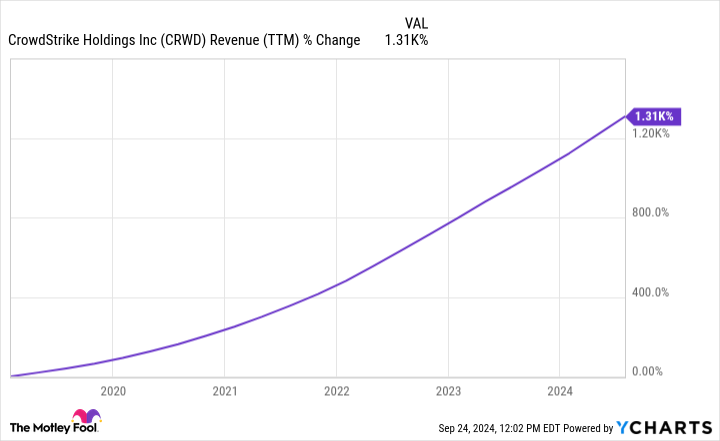On July 19, a defect in a software update from cybersecurity specialist CrowdStrike (NASDAQ: CRWD) caused one of the largest IT outages in history. Around the world, flights were canceled, financial institutions were unable to process transactions, and investors started panicking.
At the time of the outage, shares of CrowdStrike were trading near all-time highs. But less than one month later, the stock had already tumbled by more than 40%.
I don’t believe investors were behaving irrationally. In its filings with the Securities and Exchange Commission (SEC), CrowdStrike’s own management says, “If our solutions … are perceived to have defects, errors, or vulnerabilities, our brand and reputation would be harmed, which would adversely affect our business and results of operations.”
In short, its software had the defect and caused the outage. Therefore, I believe it’s very safe to say that CrowdStrike had an elevated risk of suffering damage to its reputation. Realizing this, investors were behaving rationally by selling their positions in CrowdStrike stock.
But it could turn out to be the wrong decision nevertheless. If what CrowdStrike’s co-founder and CEO George Kurtz just said is true, then this cybersecurity company has already bounced back almost as if nothing happened.
Is CrowdStrike’s reputation really still intact?
On Sept. 17, Kurtz gave a presentation at its Fal.Con conference. And during his presentation, he casually noted, “Our pipeline generation has returned to pre-incident levels.” But there’s nothing casual about that statement whatsoever.
For context, CrowdStrike has been an absolute powerhouse of a growth company. It grows by attracting new customers to its cybersecurity platform as well as by upselling its customers on one of its many cybersecurity products. With both of these growth engines humming, its top-line growth has been spectacular.
The downside to growth of this caliber is that investors pushed CrowdStrike stock to an expensive valuation — it traded at nearly 30 times its trailing sales earlier this year.
Therefore, the IT outage presented two problems for CrowdStrike’s shareholders. First, it could have potentially damaged its growth rate as customers switched to a different provider or hesitated to sign new deals. Second, if growth slowed, then CrowdStrike’s premium valuation would fall, which would also drag the stock down.
However, CrowdStrike’s business appears to have avoided long-term damage to its reputation, according to the pithy statement from Kurtz. Investors can consequently breathe a cautiously optimistic sigh of relief.
Business as usual for CrowdStrike?
By sometime around 2030, CrowdStrike wants to be generating over $10 billion in annual recurring revenue. For perspective, the company had $3.8 billion in annual recurring revenue as of its fiscal second quarter of 2025.
CrowdStrike’s Q2 ended July 31. So it wasn’t clear at the time whether the incident on July 19 had caused any real disruption. But according to Kurtz, the pipeline of potential new deals is full and the company’s vision remains resolutely fixated on its $10 billion goal.
The company isn’t expected to report financial results again until late November. So investors need to patiently await more signals regarding the health of the business. But according to Kurtz, CrowdStrike has already bounced back from the IT outage. And if that’s really the case, then that’s extremely good news for long-term investors.
Regarding what can go wrong with a software business such as this, CrowdStrike just made it through a really bad scenario. I’ll stop short of calling it a worst-case scenario, as a breach would be worse. But causing a major outage in a competitive field can ruin a company.
Yet, CrowdStrike could be overcoming the setback in short order. If it can bounce back from this, CrowdStrike can likely bounce back from a lot of things in the future. And that’s why Kurtz’s comments regarding the company’s pipeline are very important for investors.
Should you invest $1,000 in CrowdStrike right now?
Before you buy stock in CrowdStrike, consider this:
The Motley Fool Stock Advisor analyst team just identified what they believe are the 10 best stocks for investors to buy now… and CrowdStrike wasn’t one of them. The 10 stocks that made the cut could produce monster returns in the coming years.
Consider when Nvidia made this list on April 15, 2005… if you invested $1,000 at the time of our recommendation, you’d have $760,130!*
Stock Advisor provides investors with an easy-to-follow blueprint for success, including guidance on building a portfolio, regular updates from analysts, and two new stock picks each month. The Stock Advisor service has more than quadrupled the return of S&P 500 since 2002*.
*Stock Advisor returns as of September 23, 2024
Jon Quast has no position in any of the stocks mentioned. The Motley Fool has positions in and recommends CrowdStrike. The Motley Fool has a disclosure policy.
CrowdStrike Caused 1 of the Biggest IT Outages Ever. You’ll Never Believe What Its CEO Said Is Happening With the Business Now. was originally published by The Motley Fool
Source Agencies



